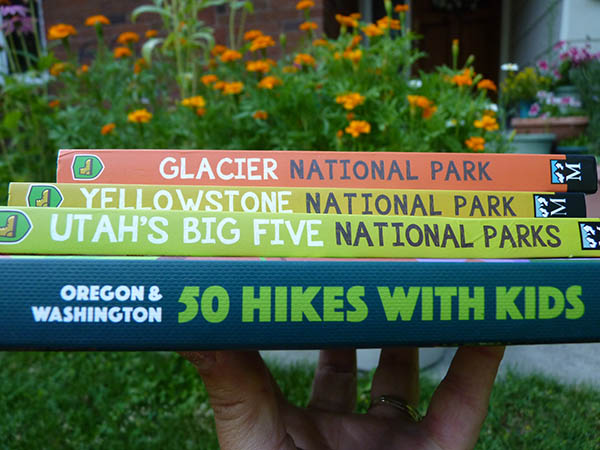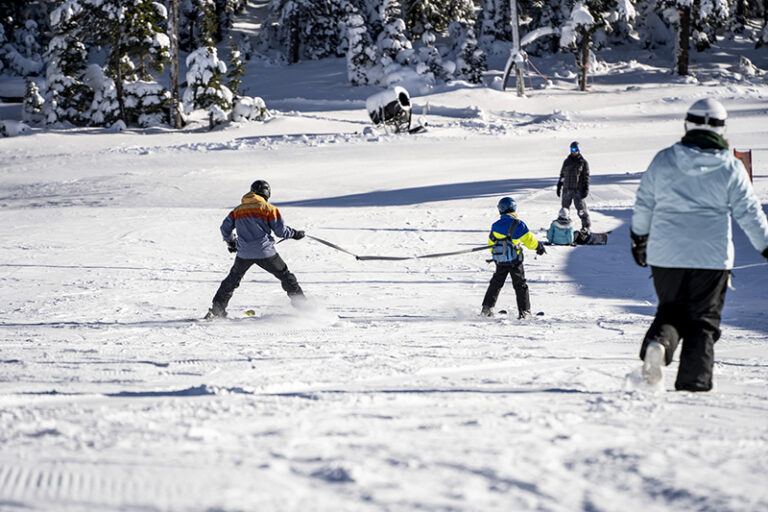When exploring the outdoors or hiking with our children, “It’s easy for us to get frustrated,” says Harley McAllister, a father of four boys who lives in Spokane Valley. “We’re thinking, I don’t want to be sitting by this river and throwing sticks in it and watching leaf boats float by; I want to get to the thing we came to see.”
But McAllister has learned that kids offer a unique perspective. “The number one thing to keep in mind is that kids have different objectives and goals than adults. We tend to think, we’re going to this iconic place in this amount of time to see this amazing thing. We can become way too focused on the destination,” he says. “But kids don’t work that way. If we want kids to enjoy and appreciate nature, we need to allow them to explore and discover [at their own pace]. We can’t put a timetable on that.”

Exploring National Parks as a Family
McAllister knows this well because he and his wife, Abby, have spent an enviable amount of time exploring some of America’s most beloved national parks, and writing about some of those adventures for Out There. Also, what started as personal research for an extensive national parks tour in fall 2014—upon the family’s return to the U.S. after four years living and teaching in the Dominican Republic—turned into an “Adventuring with Kids” family guidebook series, published earlier this year by Mountaineers Books.
So far, there are three books available in the series that cover Yellowstone, Glacier, and five of Utah’s national parks. Their Yosemite guidebook debuts spring 2019. Each book includes detailed information for field-tested and approved hikes, campgrounds, and other activities that Harley and Abby experienced with their children, now ages 6-17. Their honest, candid advice is encouraging, and the suggested itineraries— with three, five, and seven-day plans—are especially valuable. “Your kids will have a lot more love of nature and fond memories of your trip if you do a few things well, rather than try to check off a bunch of activities,” says McAllister.
50 Hikes with Kids
Another new family guidebook is “50 Hikes with Kids: Oregon and Washington,” by Wendy Gorton. It also functions as a science and activity guide that’s exceptionally user-friendly for both parents and children. Gorton, a science educator, includes a five-item scavenger hunt for each hike, with color pictures and explanations about each item, such as geologic features, landmarks, or animal and plant species. Because most of the hikes are in the western half of both Oregon and Washington, with only ten hikes located in central and southwest Washington and northeast Oregon, this guidebook is best for those traveling to the Pacific Northwest coastal regions.
Keeping Kids Energized—Snacks & Packs
Inspired for more of your own family travel adventures? Here are some additional tips from guidebook author Harley McAllister.
- Take Regular Snack Breaks: “Snacks are a crucial element to doing these types of outdoor adventures with kids. With their little bodies, they don’t have the energy reserves like we do. Snacks make it fun and special, lift their spirits, and get them back on the trail,” he says. “We have a big bin of snacks, and at the beginning of each day, each kid gets to choose their own for the day.” McAllister recommends regular 5-minute snack breaks, with fun foods like chocolate-covered granola bars and electrolyte drinks. Though they generally eat healthy, indulging a bit on snacks for “high-activity days” helps to excite their kids.
- Let Kids Carry Some Gear: As for daypacks, children can carry their own essentials, in addition to snacks, including a water bladder system or water bottle, fleece jacket, and waterproof rain jacket like the McAllister-recommended Froggtoggs.
- Stay Clean: Because many national park campgrounds are rustic, McAllister recommends planning every three or four days to stay at one providing showers, or “mix it up and stay at a hotel every five days.” He says that “wet wipes are critical,” especially in bear country. Also, everyone should wear merino wool socks, he says, “to prevent blisters, regulate temperature, and keep feet from getting clammy while hiking.”
- Reduce Stress: Always have a campsite reservation for your arrival day, then move to a first-come/first-serve site deeper into a national park, as needed. This can get you closer to your destinations and hiking trailheads, as well as decrease daily time spent driving throughout the park.
- Food Planning: Organize and pack food in bins, making it easy to move in and out of the car and to a campsite’s bear-proof storage box. To get an early start on the day, especially when driving to the next campsite, he recommends planning “a cold breakfast, such as muffins, fruit, or yogurt cups—something kids can eat in the car while we’re driving.”
Amy S. McCaffree is special section editor and the Out There Kids columnist. She wrote about backcountry adventuring with kids in the last issue.
[Feature photo: Amy S. McCaffree]













